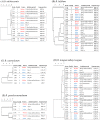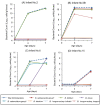Mother-to-infant transmission of intestinal bifidobacterial strains has an impact on the early development of vaginally delivered infant's microbiota
- PMID: 24244304
- PMCID: PMC3828338
- DOI: 10.1371/journal.pone.0078331
Mother-to-infant transmission of intestinal bifidobacterial strains has an impact on the early development of vaginally delivered infant's microbiota
Abstract
Objectives: Bifidobacterium species are one of the major components of the infant's intestine microbiota. Colonization with bifidobacteria in early infancy is suggested to be important for health in later life. However, information remains limited regarding the source of these microbes. Here, we investigated whether specific strains of bifidobacteria in the maternal intestinal flora are transmitted to their infant's intestine.
Materials and methods: Fecal samples were collected from healthy 17 mother and infant pairs (Vaginal delivery: 12; Cesarean section delivery: 5). Mother's feces were collected twice before delivery. Infant's feces were collected at 0 (meconium), 3, 7, 30, 90 days after birth. Bifidobacteria isolated from feces were genotyped by multilocus sequencing typing, and the transitions of bifidobacteria counts in infant's feces were analyzed by quantitative real-time PCR.
Results: Stains belonging to Bifidobacterium adolescentis, Bifidobacterium bifidum, Bifidobacterium catenulatum, Bifidobacterium longum subsp. longum, and Bifidobacterium pseudocatenulatum, were identified to be monophyletic between mother's and infant's intestine. Eleven out of 12 vaginal delivered infants carried at least one monophyletic strain. The bifidobacterial counts of the species to which the monophyletic strains belong, increased predominantly in the infant's intestine within 3 days after birth. Among infants delivered by C-section, monophyletic strains were not observed. Moreover, the bifidobacterial counts were significantly lower than the vaginal delivered infants until 7 days of age.
Conclusions: Among infants born vaginally, several Bifidobacterium strains transmit from the mother and colonize the infant's intestine shortly after birth. Our data suggest that the mother's intestine is an important source for the vaginal delivered infant's intestinal microbiota.
Conflict of interest statement
Figures




References
-
- Blaut M, Clavel T (2007) Metabolic diversity of the intestinal microbiota: implications for health and disease. J Nutr 137: 751–755. - PubMed
-
- Adlerberth I, Lindberg E, Aberg N, Hesselmar B, Saalman R, et al. (2006) Reduced enterobacterial and increased staphylococcal colonization of the infantile bowel: an effect of hygienic lifestyle? Pediatr Res 59: 96–101. - PubMed
-
- Fanaro S, Chierici R, Guerrini P, Vigi V (2003) Intestinal microflora in early infancy: composition and development. Acta Paediatr Suppl 91: 48–55. - PubMed
Publication types
MeSH terms
LinkOut - more resources
Full Text Sources
Other Literature Sources
Medical

